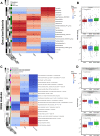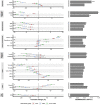The effects of the Green-Mediterranean diet on cardiometabolic health are linked to gut microbiome modifications: a randomized controlled trial
- PMID: 35264213
- PMCID: PMC8908597
- DOI: 10.1186/s13073-022-01015-z
The effects of the Green-Mediterranean diet on cardiometabolic health are linked to gut microbiome modifications: a randomized controlled trial
Abstract
Background: Previous studies have linked the Mediterranean diet (MED) with improved cardiometabolic health, showing preliminary evidence for a mediating role of the gut microbiome. We recently suggested the Green-Mediterranean (Green-MED) diet as an improved version of the healthy MED diet, with increased consumption of plant-based foods and reduced meat intake. Here, we investigated the effects of MED interventions on the gut microbiota and cardiometabolic markers, and the interplay between the two, during the initial weight loss phase of the DIRECT-PLUS trial.
Methods: In the DIRECT-PLUS study, 294 participants with abdominal obesity/dyslipidemia were prospectively randomized to one of three intervention groups: healthy dietary guidelines (standard science-based nutritional counseling), MED, and Green-MED. Both isocaloric MED and Green-MED groups were supplemented with 28g/day walnuts. The Green-MED group was further provided with daily polyphenol-rich green tea and Mankai aquatic plant (new plant introduced to a western population). Gut microbiota was profiled by 16S rRNA for all stool samples and shotgun sequencing for a select subset of samples.
Results: Both MED diets induced substantial changes in the community structure of the gut microbiome, with the Green-MED diet leading to more prominent compositional changes, largely driven by the low abundant, "non-core," microorganisms. The Green-MED diet was associated with specific microbial changes, including enrichments in the genus Prevotella and enzymatic functions involved in branched-chain amino acid degradation, and reductions in the genus Bifidobacterium and enzymatic functions responsible for branched-chain amino acid biosynthesis. The MED and Green-MED diets were also associated with stepwise beneficial changes in body weight and cardiometabolic biomarkers, concomitantly with the increased plant intake and reduced meat intake. Furthermore, while the level of adherence to the Green-MED diet and its specific green dietary components was associated with the magnitude of changes in microbiome composition, changes in gut microbial features appeared to mediate the association between adherence to the Green-MED and body weight and cardiometabolic risk reduction.
Conclusions: Our findings support a mediating role of the gut microbiome in the beneficial effects of the Green-MED diet enriched with Mankai and green tea on cardiometabolic risk factors.
Trial registration: The study was registered on ClinicalTrial.gov ( NCT03020186 ) on January 13, 2017.
Keywords: Cardiometabolic health; Meat; Mediterranean diet; Microbiota; Nutrition; Polyphenols; Weight loss.
© 2022. The Author(s).
Conflict of interest statement
IY is an advisor for Mybiotics Ltd. IS advises the nutritional committee of Hinoman, Ltd.
DK serves as Senior Scientific Advisor to Diversigen, Inc. The remaining authors declare that they do not have any competing interests.
Figures





References
-
- Shai I, Schwarzfuchs D, Henkin Y, et al. Weight loss with a low-carbohydrate, Mediterranean, or low-fat diet. N Engl J Med. 2008;359(3):229–241. - PubMed
-
- American Diabetes Association AD 4. Lifestyle management: standards of medical care in diabetes-2018. Diabetes Care. 2018;41(Suppl 1):S38–S50. - PubMed
-
- De Filippis F, Pellegrini N, Vannini L, et al. High-level adherence to a Mediterranean diet beneficially impacts the gut microbiota and associated metabolome. Gut. 2016;65(11):1812–1821. - PubMed
Publication types
MeSH terms
Substances
Associated data
Grants and funding
LinkOut - more resources
Full Text Sources
Medical

